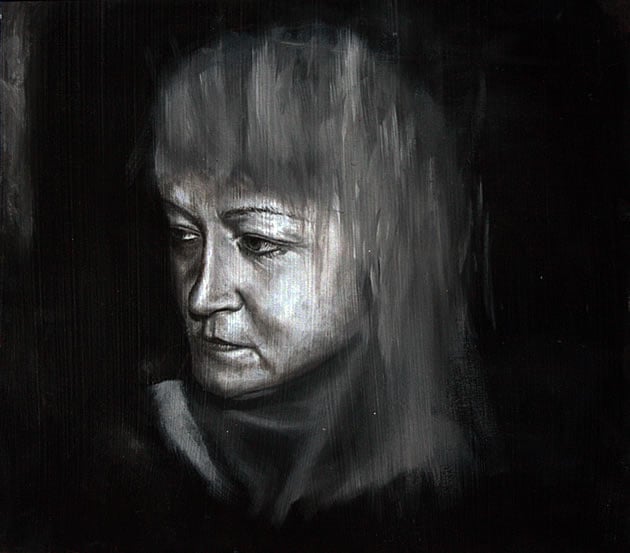Last Updated on April 2, 2023
This is the kind of high school art project that makes you catch your breath. It is the work of Grace Pickford, a Year 13 student from Pukekohe High School, Auckland. Grace’s NCEA Level 3 Painting folio (the equivalent of A Level Art) was awarded Excellence, Scholarship and Top in New Zealand for Painting, 2011. There’s no other way to say it: it’s amazing.

Grace begins with material that is fraught with difficulty: photographs taken by others. Grace’s photographs, however, are not flat, second-hand images: they are the subject. They are the essence of a still life; rich in their imperfections, creases, stains and tears. They are a tiny collection of memory: a depiction of something that was before and has now been imbued with layers of time.
Grace’s work is a reminder that gaining an exceptional result is not just about meeting learning objectives, showing development or demonstrating a high level of technical skill (although Grace excels in all of these areas): it’s about communicating something that really matters. It’s about making art.
I was lucky enough to interview Grace about her painting project. Her responses are below.

Amiria: Your art project explores what happens to our memories of a person following their death, and how – like photographs – these fade, stain and become ‘discoloured’ over time. What made you choose this theme?
Grace: I’ve always loved my family’s old albums and place extra value on the ones that have been damaged over time, and at the beginning of the year I decided on a theme that expresses the mixed emotions these old photographs provoked in me. It took a lot of thinking and analysing these photographs as well as questioning my parents about the people they depicted, before I understood the subconscious thoughts I had about them that have always attracted me to them. I discovered that it’s the fact that all the people in the photos no longer exist, and the overwhelming fact that one day I no longer will either. Memories are all that remain after a person passes and in a way keep them alive, as memories fade and photographs deteriorate, so does the last part of a person’s existence.

Amiria: Prior to completing this project, you described yourself as a sketcher, with little interest in painting. You are clearly now an exceptional painter, with work that is deemed the best of all NCEA Level 3 Painting students in New Zealand in 2011. What tips or advice do you have for those who have difficulty painting and are more confident with drawing?
Grace: For me the transition into painting was probably quite different to most because I started in black and white and also went straight to painting in oils. The aspect of painting I originally found hard was working quickly while also mixing colour after colour, so in painting in black and white oils I had all the time I wanted (as oils dry slowly) as well as focusing on detail and tone rather than colour (which I had little interest in at the time). Once I became confident in painting, I took the step into colour and was just sure to be patient with myself when mixing colours and slowly became more confident with that also.

Amiria: Your work contains a good balance of tightly refined, realistic areas with those that are more abstract. Talk through the advantages of this approach, in terms of both practical and aesthetic considerations.
Grace: Because I like painting in a realistic style, I knew I had to be careful to still express concepts and ideas through my art, and avoid my work just being seen as ‘copies’ of images without provoking any thoughts in the viewer. To visually express my ideas about fading memories, and memories being damaged or covered in some way I juxtaposed realistic areas with blurring and areas that looked like stains or mistakes, as well as blurred areas and areas of one colour.
Amiria: Which artists did you study as part of your project and how did these influence your work?
Grace: I was interested in Christian Boltanski’s concepts. He expresses ideas about memories and death but avoids any sentimentality in his work, I found his views and ideas around these subjects interesting as he addressed them without fear and ignored the taboo society usually places on death-despite the fact that it is a natural part of life.
Other artists that influenced my work both visually and conceptually were New Zealand artist Barry Ross Smith, as he looked at the relationship between photography and painting, and Pedro Matos.



Amiria: Your project includes a very subtle and considered use of colour, with many pieces entirely black and white. Please talk to me about the thought process behind this.
Grace: I’ve always been attracted to images that rely solely on tone and lighting rather than colour, I think it was more a subconscious preference rather than a thought process I went through. However I think the reason I’ve always loved black and white images is that they add another layer of separation between the viewer and the work, reminding them that what they are seeing is only a representation of something that exists. This separation reminds me of the same feeling I get when looking at an old photograph, be it in colour or not, because that moment is captured yet all we have of it is a representation, giving it an ‘untouchable’ quality.

Amiria: What advice do you have for other high school art students who are hoping to achieve excellent grades?
Grace: I think with a subject like painting, or any art subject, it’s important for you as the artist to love what you are creating. If you find it visually pleasing and have an idea you are interested in and feel the need to express then the work you produce will reflect this. It’s also important to understand that not everyone has to love what you are creating, it’s good not to get to doubtful because of people’s different tastes or to get distracted by other peoples work. Talk to your teacher as much as possible about ideas and artists they recommend you to look at, as they understand the marking criteria better than anyone. However follow your gut when it comes to the bigger decisions (or at least try compromise if your teacher and your gut are telling you different things) you are the one who will spend hours on your boards so make sure you are staying on a path you’re passionate about, putting in the time needed will seem easier this way.

The last section of Grace’s portfolio was inspired by the exceptional artwork of young Lisbon artist Pedro Matos (you can see a gallery of his artwork here).


Grace Pickford is a name you should remember. Currently studying at Whitecliffe College of Arts & Design, she is set to achieve great things.
If you would like to view more outstanding student artwork, please view our Featured Art Projects.

